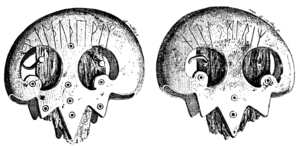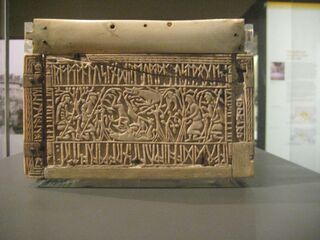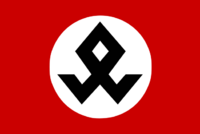Othala
Othala (ᛟ), also known as ēðel and odal, is a rune that represents the o and œ phonemes in the Elder Futhark and the Anglo-Saxon Futhorc writing systems respectively. Its name is derived from the reconstructed Proto-Germanic *ōþala- "heritage; inheritance, inherited estate". As it does not occur in Younger Futhark, it disappears from the Scandinavian record around the 8th century, however its usage continued in England into the 11th century.
As with other symbols used historically in Europe such as the swastika and Celtic cross, othala has been appropriated by far-right groups such as the Nazi party and neo-Nazis. The rune also continues to be used in non-racist contexts, both in Heathenry and in wider popular culture such as the works of J.R.R. Tolkien.
Name and etymology
The sole attested name of the rune is Old English: ēþel, meaning "homeland". Based on this, and cognates in other Germanic languages such as Old Norse: óðal and Template:Lang-ofs, the Template:Lang-gem-x-proto can be reconstructed, meaning "ancestral land", "the land owned by one's kin", and by extension "property" or "inheritance". *ōþalą is in turn derived from Template:Lang-gem-x-proto, meaning "nobility" and "disposition".[citation needed]
Elder Futhark o-rune
The o-rune is attested early, in inscriptions from the 3rd century, such as the Thorsberg chape (DR7) and the Vimose planer (Vimose-Høvelen, DR 206).
It has been suggested that the othala rune on the Ring of Pietroassa is used to represent the word "*oþal", referencing the ring as hereditary treasure.[1] Similarly, Wolfgang Krause speculated that the o rune is used as an ideograph denoting possession in the Thorsberg chape inscription, reading the inscription owlþuþewaz as O[þila] - W[u]lþu-þewaz "inherited property - the servant of Wulþuz".[2][3][4][5]
Anglo-Saxon œ-rune
Usage and shape
The Anglo-Saxon runes preserve the full set of 24 Elder Futhark runes (besides introducing innovations), but in some cases these runes are given new sound values due to Anglo-Frisian sound changes. The othala rune is such a case: the o sound in the Anglo-Saxon system is now expressed by ōs ᚩ, a derivation of the old Ansuz rune; the othala rune is known in Old English as ēðel (with umlaut due to the form ōþila-) and is used to express an œ sound, but is attested only rarely in epigraphy (outside of simply appearing in a futhark row).[citation needed] In some runic inscriptions, such as on the Seax of Beagnoth, and more commonly in manuscripts, othala is written with a single vertical line instead of the two diagonal legs, perhaps due to its simpler form.[6]
The rune is also used as a shorthand for the word "ēþel" in texts such as Beowulf, Waldere and the Old English translation of Orosius' Historiae adversus paganos.[7]
Notable attestations
Epigraphical attestations include:
- the Frisian Westeremden yew-stick, possibly as part of a given name Ƿimod (Ƿimœd)
- the Harford (Norfolk) brooch, dated c. 650, in a finite verb form: luda:gibœtæsigilæ "Luda repaired the brooch"
- the left panel of the Franks Casket, twice: tƿœgen gibroþær afœddæ hiæ ƿylif "two brothers (scil. Romulus and Remus), a she-wolf nourished them".
Rune poem
The Anglo-Saxon rune poem preserves the meaning "an inherited estate" for the rune name:
|
ᛟ bẏþ oferleof æghƿẏlcum men, |
[An estate] is very dear to every man, |
Modern use
Far-right iconography
Deliberate use as a far-right symbol
The symbol derived from othala with wings or feet (serifs) was the badge of the SS Race and Settlement Main Office, which was responsible for maintaining the racial purity of the Nazi Schutzstaffel (SS).[8] It was also the emblem of ethnic Germans (Volksdeutsche) of the 7th SS Volunteer Mountain Division Prinz Eugen operating during World War II in the Nazi Germany-sponsored Independent State of Croatia.[citation needed]
The rune and winged symbol have been used by the Neo-Nazi Wiking-Jugend in Germany, and in South Africa by the Anglo-Afrikaner Bond, the Boeremag, the Blanke Bevrydingsbeweging,[9] the Italian neo-fascist group National Vanguard,[10] the Afrikaner Student Federation and the far-right wing White Liberation Movement before it was disbanded.[11][12][better source needed] In November 2016, the leadership of the National Socialist Movement announced their intention to replace the Nazi-pattern swastika with the othala rune on their uniforms and party regalia in an attempt to enter mainstream politics.[13][14] The rune was further used, along with other traditional symbols from European cultures such as a Tiwaz rune and a Celtic cross, and slogans associated with Nazism and far-right extremism by the Christchurch mosque shooter Brenton Harrison Tarrant.[15]
Heathen Front was a Neo-Nazi group, active during the 1990s to 2005, that espoused a racist form of Heathenry.[16] It described its ideas as odalism in reference to the alternative name for othala.[17]
Alleged use as a far-right symbol
In April 2014, the British Topman clothing company apologised after using the othala rune in one of their clothing lines, due to its usage by far-right groups.[18]
At the Conservative Political Action Conference (CPAC) held in Orlando, Florida, on February 25–28, 2021, the floor layout of the main stage resembled the winged othala rune, leading to speculation on social media as to why that design was chosen. CPAC chairman Matt Schlapp said comparisons were "outrageous and slanderous".[19] Design firm Design Foundry later took responsibility for the design of the stage, saying that it "intended to provide the best use of space, given the constraints of the ballroom and social distancing requirements." Ian Walters, director of communications for the ACU and CPAC, said they would stop using Design Foundry.[20][21]
The neo-folk group Death in June used othala on the cover of their 7'' Come Before Christ And Murder Love alongside their "Totenkopf 6" logo.[22] The group does not openly support far-right ideologies however scholars have noted the group's fascination with Nazism and extensive usage of Nazi, and more widely fascist, imagery.[23]
Heathenry
Othala, along with other runes more widely, often feature prominently in the practices of Heathens,[24][25][26] and are commonly used to decorate items and in tattoos.[27]
The use of runes such as othala by far-right groups has been strongly condemned by some Heathen groups, including Asatru UK which released a public statement that "[it] is categorically opposed to fascist movements, or any movements, using the symbols of our faith for hate".[28]
Popular culture
The Anti-Defamation League notes that because it is part of the runic alphabet, the othala rune is used widely in a non-racist manner and should be interpreted in conjunction with its context.[29]
As with other historical runes, othala is used by J.R.R. Tolkien in The Hobbit as seen on Thror's map of Erebor, and as a base for the dwarvish Cirth writing systems used in The Lord of the Rings and described in Tolkien's Legendarium.[30][31] Othala is also used as the symbol for the "Lore" resource in Northgard, released in 2018.[32]
In Stargate SG-1, Othala is a world in the Ida Galaxy where the Asgard had lived.[citation needed]
See also
- Troll cross – A symbol which resembles the rune
References
- ↑ Silva 2006, p. 396.
- ↑ Krause, Wolfgang, 'Die Runendenkmäler und ihre Sprache' In: Von der Bronzezeit bis zur Völkerwanderungszeit, (ed.) Klose, Olaf. Neumünster 1964 [reprint 1979], 311-325.
- ↑ Krause, Wolfgang, Herbert Jankuhn. Die Runeninschriften im älteren Futhark, Göttingen, 1966.
- ↑ The interpretation by Krause follows an earlier suggestion by Helmut Arntz, Handbuch der Runenkunde, 2nd ed., Halle/Saale 1944.
- ↑ Spurkland 2005, pp. 47-48.
- ↑ Page, R. I. (2003). An introduction to English runes (2nd ed.). Woodbridge, UK: Boydell Press. p. 40. ISBN 085115946X.
- ↑ Silva 2006, p. 393.
- ↑ Lumsden, Robin (1995). SS Regalia. Edison, NJ: Book Sales, Inc.. p. 35. ISBN 9780785802280.
- ↑ Schönteich, Martin and Boshoff, Henri Volk, faith and fatherland: the security threat posed by the white right Institute for Security Studies (South Africa)(2003) p48
- ↑ Colborne, Michael (22 January 2020). "Ukraine's Far Right Is Boosting A Pro-Putin Fascist". https://www.bellingcat.com/news/2020/01/22/ukraines-far-right-is-boosting-a-pro-putin-fascist/.
- ↑ "Neo-Nazi flag symbolism". flagspot.net. https://flagspot.net/flags/qt-z_sym.html#odal.
- ↑ Visser, Myda Marista Die Ideologiese Grondslae En Ontwikkeling Van Die Blanke Fascistiese Bewegings In Suid-Afrika, 1945- 1995 (The ideological foundations and development of white fascist movements in South Africa, 1945-1999) M.A. thesis University of Pretoria (1999) p. 164
- ↑ Smith, Rohan (15 November 2016). "Bizarre, bold reason America's white supremacists just banned swastika". News.com.au. http://www.news.com.au/world/north-america/americas-white-supremacists-ban-swastika-in-bold-attempt-to-go-mainstream/news-story/53f68100ba52a1e33b13cf25b794d028.
- ↑ Schoep, Jeff (4 November 2016). "National Socialist Movement: Announcement". Press Release. National Socialist Movement (US). https://www.nsm88.org/nsmnews/NSMAnnouncement_Nov_2016.htm. Retrieved 27 February 2021.
- ↑ "White Supremacist Terrorist Attack at Mosques in New Zealand". March 15, 2019. https://www.adl.org/blog/white-supremacist-terrorist-attack-at-mosques-in-new-zealand.
- ↑ Bogdan, Henrik; Hammer, Olav, eds (2016). Western Esotericism in Scandinavia. BRILL. pp. 384, 621. ISBN 9789004325968.
- ↑ Gregorius, Frederick (2006). Old Norse religion in long-term perspectives: origins, changes, and interactions: an international conference in Lund, Sweden, June 3-7, 2004. Lund: Nordic Academic Press. p. 390. ISBN 9789189116818.
- ↑ Hayward, Stephen (2014-04-13). "Fascism disaster: Topman withdraws 'Nazi' clothing line after online shopper points out SS insignia". https://www.mirror.co.uk/news/uk-news/fascism-disaster-topman-withdraws-nazi-3406462.
- ↑ Walters, Joanna (1 March 2021). "CPAC: Hyatt Hotels says stage design resembling Nazi rune is 'abhorrent'". The Guardian. https://www.theguardian.com/us-news/2021/mar/01/cpac-2021-stage-design-nazi-sign-odal-othala-rune-hyatt-hotels-hate-symbol-abhorrent.
- ↑ Kornbluh, Jacob (2021-03-03). "Design firm takes responsibility for CPAC stage controversy". The Forward. https://forward.com/fast-forward/465136/design-firm-takes-responsibility-for-cpac-stage-controversy/.
- ↑ Ibrahim, Nur Nasreen (2021-03-03). "Was the CPAC Stage Intentionally Shaped Like a Nazi Symbol?". https://www.snopes.com/fact-check/cpac-stage-nazi-symbol/.
- ↑ Discogs.
- ↑ Heilbronner 2015, pp. 270-286.
- ↑ Blain 2005, pp. 181-208.
- ↑ Harvey 1997, p. 61.
- ↑ Calico 2018, p. 118.
- ↑ Calico 2018, pp. 391-392.
- ↑ AUK statement.
- ↑ ADL, Othala.
- ↑ Tolkien 1937.
- ↑ Tolkien 1955.
- ↑ Northgard.
Bibliography
Primary
- Tolkien, J.R.R. (1937). The Hobbit. London: George Allen & Unwin..
- Tolkien, J. R. R. (1955). The Return of the King – Being the Third Part of The Lord of the Rings; Appendix E. London: George Allen & Unwin.
Secondary
- Blain, Jenny (2005). Modern paganism in world cultures: comparative perspectives. Santa Barbara, Calif.: ABC-CLIO. ISBN 9781851096084.
- Calico, Jefferson F. (2018). Being Viking: heathenism in contemporary America. Bristol. p. 118. ISBN 9781781792230.
- Harvey, Graham (1997). Listening people, speaking earth: contemporary paganism. London: Hurst & Co. p. 61. ISBN 978185065-2724.
- Heilbronner, Oded (2015). "The Wewelsburg Effect: Nazi Myth and Paganism in Postwar European Popular Music". Revisiting the "Nazi Occult": Histories, Realities, Legacies. German History in Context (Boydell & Brewer): 270–286. doi:10.1017/9781782046080.013. ISBN 9781782046080. https://www.cambridge.org/core/books/abs/revisiting-the-nazi-occult/wewelsburg-effect-nazi-myth-and-paganism-in-postwar-european-popular-music/710E161F1EA44EB2F8690A7FB165010B.
- Silva, Inmaculada Senra (1 January 2006). "A note on the meaning of os in the Old English Rune Poem". Epos: Revista de filología (22): 393. doi:10.5944/epos.22.2006.10523. ISSN 2255-3495. https://revistas.uned.es/index.php/EPOS/article/view/10523/10061.
- Spurkland, Terje (2005). Norwegian Runes and Runic Inscriptions. Boydell Press. ISBN 1-84383-186-4. https://books.google.com/books?id=1QDKqY-NWvUC.
- "Othala Rune" (in en). https://www.adl.org/resources/hate-symbol/othala-rune.
- "Death In June - Come Before Christ And Murder Love" (in en). 1985. https://www.discogs.com/release/141748-Death-In-June-Come-Before-Christ-And-Murder-Love.
- "Asatru UK, In response to the Daily Telegraph article" (in en). https://www.facebook.com/asatru.uk.auk/posts/2445282542368140.
- "Northgard - Balancing Patch 7 - July 2021 - Steam News" (in en). 20 July 2021. https://store.steampowered.com/news/app/466560/view/5016431176761421493.
External links
 |







